Balance Tracking Systems – Test your Balance
The Balance Tracking Systems (BTrackS) Balance Test is used to measure balance and understand how well a person’s brain works. The tests have people stand on a balance plate and try to remain still while adding different challenges. Each individual test can last for 30 seconds at a time with comprehensive testing lasting ten minutes, but it can be shorter or longer. It helps specialists, like chiropractic neurologists, assess the neurological system to determine how well that it is working. This can include how well one is recovering from an injury to the brain or head.
What is balance?
Balance is an important part of our everyday life. It involves a number of different elements, including balance control, stability, and coordination. Balance control refers to the ability to maintain balance while standing or performing balance exercises. Stability refers to the maintenance of balance in response to changes in the environment or movements performed. Coordination is required for complex balance tasks and refers to the ability to control different body parts to perform balance tasks.
When you balance, your center of pressure (COP) is the point where your body weight is evenly distributed. Your balance depends on maintaining this center of pressure while standing or doing balance exercises.
Balance is an incredibly complex thing and lots of brain power is needed for a person to coordinate the joints and muscles of the body to maintain balance. Many scientists hypothesize that the ability of humans to balance and walk upright is one of the things that drove the evolution of our brains and intelligence.
The BTrackS Balance Test looks at balance and how well your brain is working. Your center of pressure is like a middle point where all the weight from your body is evenly spread out. By doing balance exercises, you can help keep this middle point stable so it’s easier to balance!
How the BTrackS balance test works
The BTrackS balance test is a way to measure balance and fall risk using a specialized balance force plate. If you are old enough, think of a Nintendo Wii Balance Board but more medically research-based and less like a video game.
The balance plate used for the BTrackS balance test measures the center of pressure (CoP) of a person’s sway during static and dynamic balance tasks. The CoP is measured by sensors that detect force applied on different points of the balance plate. The CoP provides important information about balance, stability, and postural control within a given stance or movement task that can be used to assess an individual’s balance performance.
The different tests compare the individual’s balance to others in their age group to get a percentile ranking. This ranking helps tell if they are at low, moderate, or high risk of falling. This balance test also tracks balance and fall risk in real time, allowing practitioners to monitor balance over time. This is particularly useful for assessing concussion recovery or other neurological problems where balance is affected.
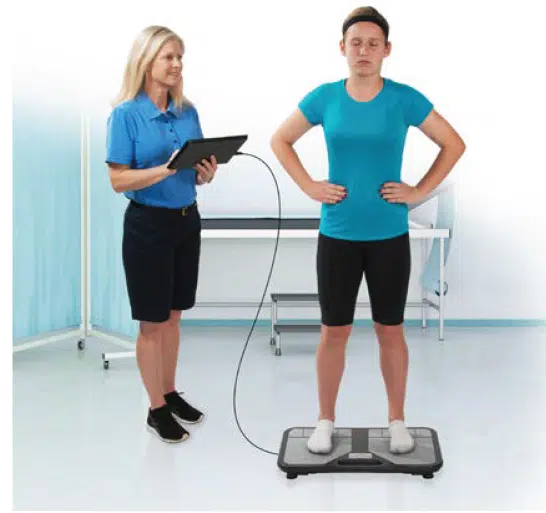
What the BTrackS Balance Test Measures
The BTrackS balance test measures balance and fall risk. The results will show if they are at low, moderate, or high risk of falling.
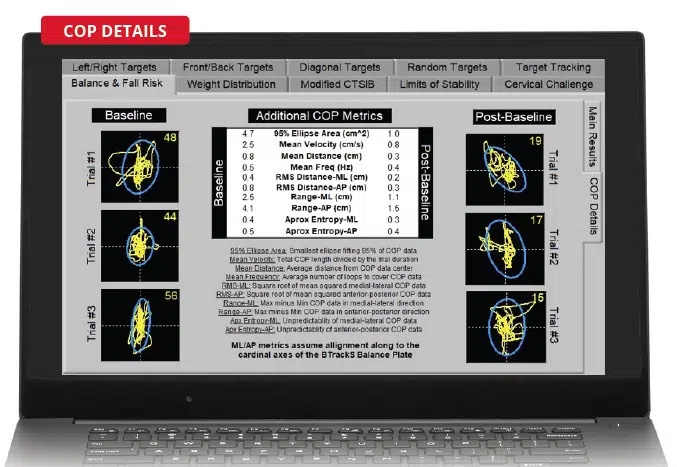
The tests measure the movement of something called the Center of Pressure or CoP. The center of pressure is a location denoting the average location of force being applied to the ground by the individual. When a person is standing normally, there is one COP for them located somewhere in between the feet.
No matter how hard someone tries to stand still, you can never attain perfect balance. Because of the inherent instability of having multiple joints stacked up in the body, there will always be some degree of sway. That sway or movement of the center of pressure is measured by the force plates in BTrackS.
This movement of the COP can be recorded, measured and represented by a line drawn on the ground, which is shown by the yellow lines in the graphic labeled “COP Details”. One data point that BTrackS can determine is the total distance traveled by the COP in centimeters. In the “COP Details” graphic, the Baseline has three trials of 48 cm, 44 cm and 56 cm. A smaller distance indicates more stability. The average speed of movement of the COP and frequency of direction change can also be measured with slower movement speed and decreased frequency indicating more stability and better balance.
All of these factors can be measured using different variables to challenge a patient’s balance. You can have a person close their eyes or stand on a soft surface. You can also have a person stand on one foot or turn their head. Each of these can add challenges in order to assess a person’s overall balance.
Benefits of Using BTrackS for Neurological Problems
The BTrackS balance test is a valuable tool for assessing balance, stability and fall risk for individuals with concussion and other neurological problems. It can provide an accurate assessment of balance and stability in those who have suffered from a traumatic brain injury or other neurological events, such as stroke or severe headaches. This balance test is a reliable tool for diagnosing balance deficits associated with these issues.
By using the balance test, medical professionals can make better-informed decisions about treatment plans and rehabilitation goals for individuals with concussions or other neurological issues. This can lead to more effective treatments that may reduce symptoms and improve overall quality of life. Additionally, the balance test can be used to track progress over time by providing measurable indicators of improvement, enabling healthcare providers to adjust their treatment plans accordingly.
The balance test is also useful in helping to identify factors that may increase the risk of falls in those suffering from concussion or other neurological issues. By identifying these risks early on, steps can be taken to reduce the likelihood of falls occurring in the future. Furthermore, it provides objective data which helps clinicians form opinions on if certain activities are safe or not safe for an individual to participate in given their unique balance deficits.
In addition to helping assess balance deficits associated with concussion or other neurological problems, the BTrackS balance test is also beneficial in preventing future injuries by providing exercise programs tailored specifically to each individual’s needs. Exercise programs designed based on data obtained from the balance test have been shown to improve balance and stability over time. This leads to improved physical performance overall and reduced risk of falling due to improved body control following activities such as walking or running.
Using an objective computerized test can be extremely useful. Testing can be performed rapidly and data can be tracked over time. This means it can be used to track the progress of a person’s balance issues, monitoring them over time.
BTrackS Balance testing is particularly useful in concussion diagnosis and management. First of all, it can be considered a gold standard test as it has excellent sensitivity in detecting the presence of a concussion. Secondly, management can be improved by knowing when a person has healed appropriately. Ideally, one could compare an individual’s current score to a baseline score to see when the score has returned to normal. If needed, a healthcare provider can also compare a concussed individual to normative data for their age and sex and when reached, this test can be considered to be normalized.
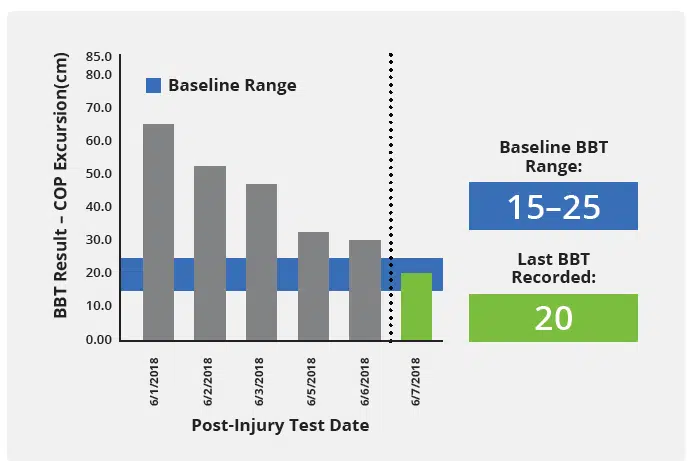
Overall, using the BTrackS balance test provides reliable data which helps clinicians accurately assess balance deficits associated with concussions and other neurological problems as well as measure improvements over time as treatment progresses. Furthermore, it can help identify factors that may increase fall risks while also providing customized exercise programs tailored specifically to each individual’s unique needs which will help prevent future injuries while improving overall physical performance.
Types of Balance Assessments & Tests
The balance test uses five different training programs to help measure balance and fall risk. One program involves standing on a balance plate and moving your center of pressure into different targets. Another program has you walk or run while focusing on controlling your body movements. Other programs have you do exercises like reaching out with one foot, balancing on one leg, or doing balance drills like hopping in place.
BTrackS offers an array of protocols for balance assessment and training. The assessment protocols consist of the following:
Balance and Fall Risk Assessment
BTrackS has a comprehensive balance assessment called the BTrackS Balance Test (BBT) that provides a detailed analysis of postural sway. The postural sway is calculated each trial, and the results are compared with a vast database of normal patients (20,000+ norms) to determine percentile rankings. Additionally, the test provides a fall risk assessment grade of High, Moderate or Low to compare you to others of your age and sex.

Weight Distribution
This protocol accurately determines the percentage of weight distribution in the front/back & left/right directions, as well as the body center of pressure’s location in relation to your overall postural alignment.

CTSIB
The CTSIB assesses the three main feedback systems used for balance. Most people know their is a role the inner ear plays in balance and this is part of the vestibular system. Vision is the next sensory system as it gives you idea when you are moving in relation to your environment. Proprioception is knowing where your body is in space and how it is moving or positioned. The Clinical Test of Sensory Integration and Balance (CTSIB) also gives the patient a percentile ranking to compare with normal people.

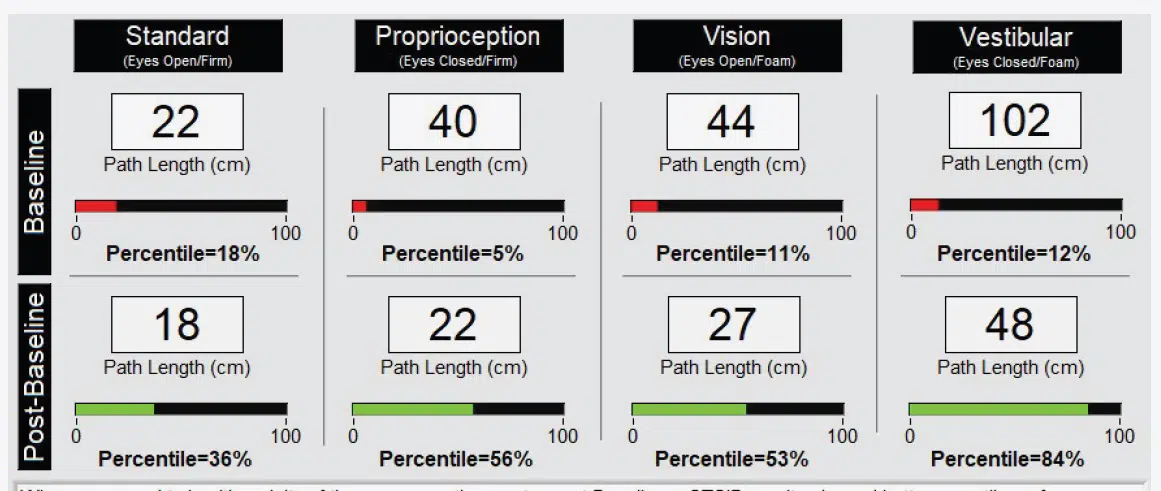
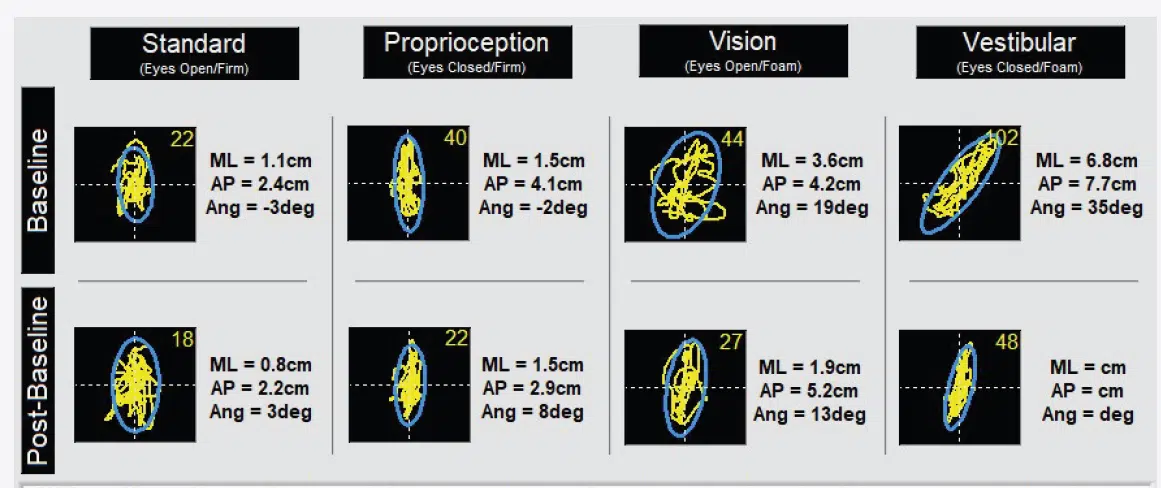
Limits of Stability
This biofeedback assessment measures how far that you can push your balance without losing it. With your feet flat on the plate, an examinee would lean in each direction as far as they possibly could. Calculations are made in real-time of the total area and the area in each quadrant of the plate, which gives you and idea of your functional base of support .
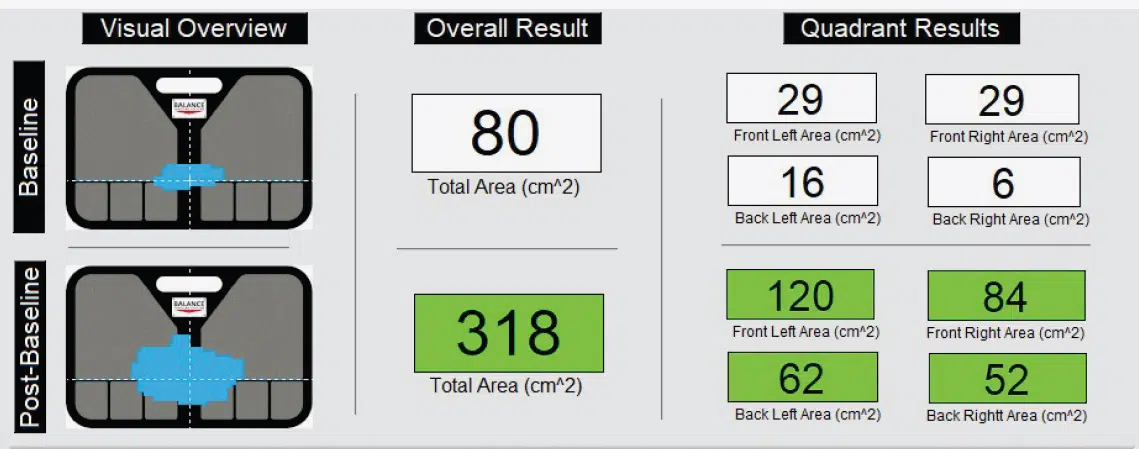
Cervical Challenge
In this protocol, the examinee’s head is placed in 11 different positions and postural sway is measured compared to neutral. This can show issues in different areas of the vestibular system.
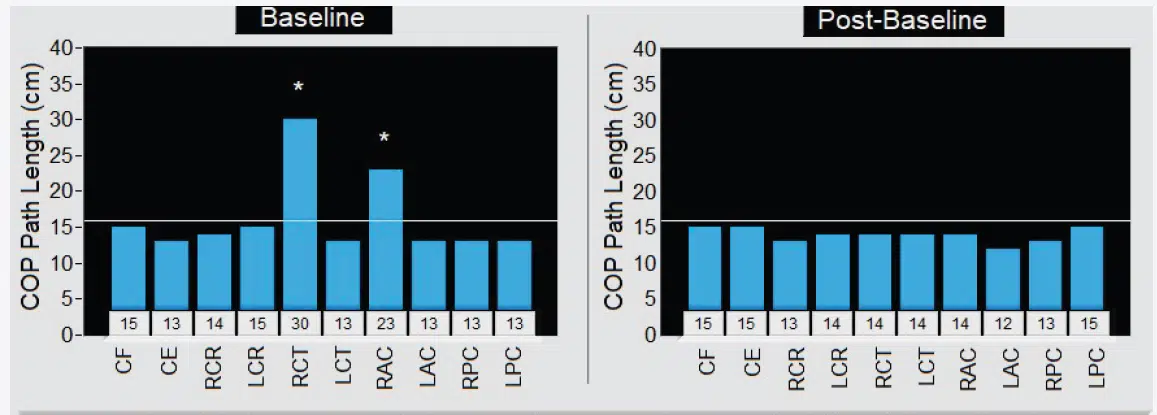
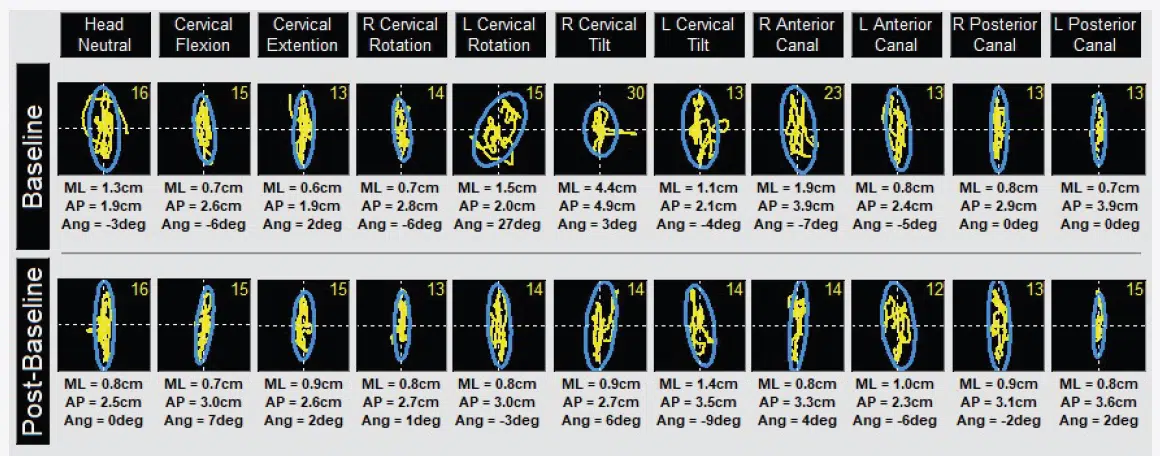
Single Leg Stance
The Single Leg Stance Test is just like it sounds in that you are standing on one leg and comparing the amount of postural sway between the feet. Ideally, there should be no difference between sides but comparing the path length between the right and left results in the calculation of a Symmetry Index. Less than a 15% difference between sides is considered symmetrical.

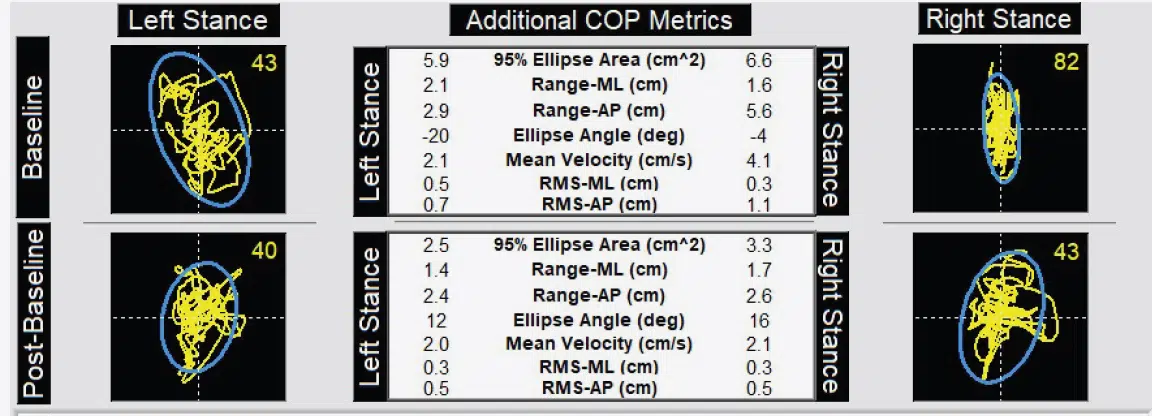
Balance Training and Rehabilitation after Testing
BTrackS provides diverse training protocols that concentrate on enhancing postural control. Finally, the balance test can also provide exercise programs that are tailored to each individual’s needs which can help prevent future injuries and improve overall physical performance. It does this by having someone stand on a balance plate and move their center of pressure into different targets on the screen. These protocols comprise of:
- Left/Right
- Front/Back
- Diagonal
- Random Target
- Target Tracking Acquisition
BTrackS Balance Training assists individuals in regulating postural sway using biofeedback. During the training process, a person’s center of pressure’s real-time position is shown on an image of the BTrackS Balance Plate. To complete the training successfully, the individual must move their center of pressure towards targets of varying complexity.
Each of the five training programs runs for a default duration of three minutes, but the time can be customized to be shorter or longer. The Left/Right and Front/Back protocols present uniaxial targets of various sizes and locations. The Diagonal protocol delivers biaxial targets of varying sizes and positions. The Random protocol presents multiaxial targets that randomly appear in different sizes. Lastly, the Target Tracking protocol involves a circular target that moves around the screen, and the center of pressure should remain inside the circle as much as possible.
Conclusion
The BTrackS balance test is a reliable tool for assessing balance deficits associated with concussion or other neurological problems. It can be used to accurately measure balance and stability while also providing exercise programs tailored specifically towards each individual’s needs, helping reduce the risk of falls and improve overall physical performance. This makes the balance test a valuable tool for medical professionals when it comes to making informed decisions about treatment plans and rehabilitation goals.
